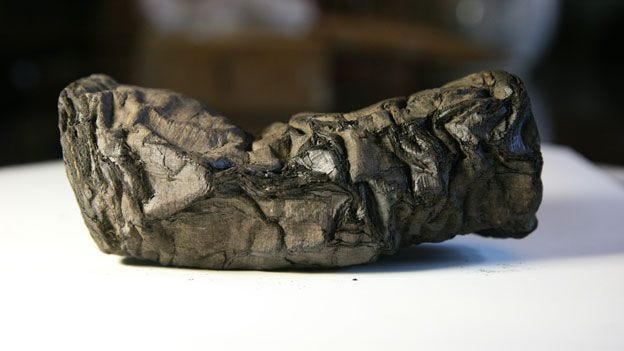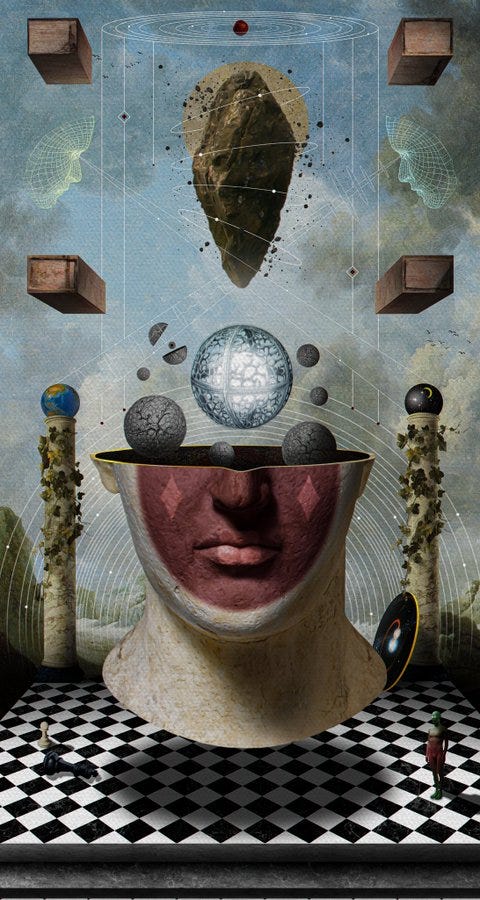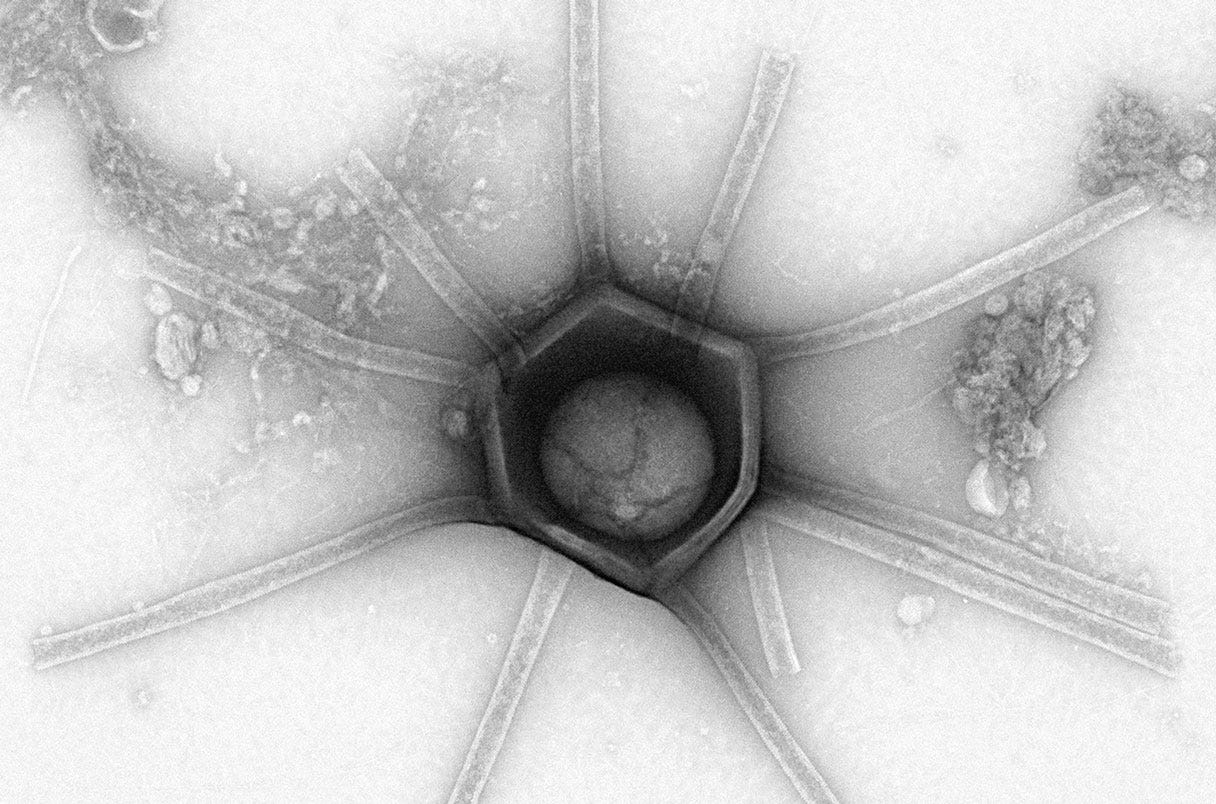Once every month or two, SoS Co-founder Roger’s Bacon writes a post for his own substack featuring various links, thoughts, quotes, and art. This month’s post happened to focus more exclusively on science (as opposed to the normal mix of science, philosophy, and culture) so he decided to share it here as well—enjoy!
1. This hyper-realistic drawing of a kidney by sfkhanvisuals:
2. Absolutely genius; preprint here.
We propose a new standard for writing author names on papers and in bibliographies, which places every author as a first author — superimposed. This approach enables authors to write papers as true equals, without any advantage given to whoever’s name happens to come first alphabetically (for example). We develop the technology for implementing this standard in LaTeX, BibTex, and HTML; show several examples; and discuss further
3. Did Scientists Accidentally Invent an Anti-addiction Drug?
People taking Ozempic for weight loss say they have also stopped drinking, smoking, shopping, and even nail biting.
4. Dunitz's Rule: “Almost every scientific publication can be improved by cutting out the first sentence”.
Resurrect an ancient library from the ashes of a volcano. Win $1,000,000. The Vesuvius Challenge is a machine learning and computer vision competition to read the Herculaneum Papyri.
In Herculaneum, twenty meters of hot mud and ash bury an enormous villa once owned by the father-in-law of Julius Caesar. Inside, there is a vast library of papyrus scrolls.
The scrolls are carbonized by the heat of the volcanic debris. But they are also preserved. For centuries, as virtually every ancient text exposed to the air decays and disappears, the library of the Villa of the Papyri waits underground, intact.While digging a well, an Italian farmworker encounters a marble pavement. Excavations unearth beautiful statues and frescoes – and hundreds of scrolls. Carbonized and ashen, they are extremely fragile. But the temptation to open them is great; if read, they would more than double the corpus of literature we have from antiquity.
Early attempts to open the scrolls unfortunately destroy many of them. A few are painstakingly unrolled by an Italian monk over several decades, and they are found to contain philosophical texts written in Greek. More than six hundred remain unopened and unreadable. What's more, excavations were never completed, and many historians believe that thousands more scrolls remain underground.
Imagine the secrets of Roman and Greek philosophy, science, literature, mathematics, poetry, and politics, which are locked away in these lumps of ash, waiting to be read!
6. New peer-reviewed articles from Seeds of Science:
We See The Sacred From Afar, To See It The Same by Robin Hanson
Principles of Categorization: a Synthesis by Davood Gozli
Perspective: Focused-Ultrasound Guided Neuropeptide Delivery as a Novel Therapeutic Approach in Psychiatry by Manjushri Karthikeyan, Ahaana Shrivastava, and Andrew Neff
7. Recent posts from the SoS “Best of Science Blogging” feed:
What should science cost? Hacking the economics of scientific equipment by David Lang
Why do most popular science books suck? by Erik Hoel
The Alien ER and the Amyloid Hypothesis by Shane Horan
Time for a Change: How Scientific Publishing is Changing For The Better
Bombs, Brains, and Science by Eric Gilliam
The Need for Long-term Research by Kevin Kelly (featuring an extended comment from yours truly with some speculation on what such projects might be)
How many people die from snakebites? Saloni Dattani
Underrated ideas in psychology by Adam Mastroianni
Ideas aren’t getting harder to find and anyone who tells you otherwise is a coward and I will fight them by Adam Mastroianni
8. Artist: Christian Rex Van Minnen (I can't find the title, but I'm calling it “Technicolor Rainbow Frog Egg Man”)
9. Discovery of facultative parthenogenesis in a new world crocodile
Over the past two decades, there has been an astounding growth in the documentation of vertebrate facultative parthenogenesis (FP). This unusual reproductive mode has been documented in birds, non-avian reptiles—specifically lizards and snakes—and elasmobranch fishes. Part of this growth among vertebrate taxa is attributable to awareness of the phenomenon itself and advances in molecular genetics/genomics and bioinformatics, and as such our understanding has developed considerably. Nonetheless, questions remain as to its occurrence outside of these vertebrate lineages, most notably in Chelonia (turtles) and Crocodylia (crocodiles, alligators and gharials). The latter group is particularly interesting because unlike all previously documented cases of FP in vertebrates, crocodilians lack sex chromosomes and sex determination is controlled by temperature. Here, using whole-genome sequencing data, we provide, to our knowledge, the first evidence of FP in a crocodilian, the American crocodile, Crocodylus acutus.
10. Parasite gives wolves what it takes to be pack leaders
“Wolves infected with a parasite that commonly infects cats were 46 times more likely to become pack leaders and 11 times more likely to start a new pack…The parasite, Toxoplasma gondii, makes its hosts bold — a mechanism that increases its survival.”
11. Artist: Vertigo
12. Recommended reading for young (and old!) biologists: “Is the cell really a machine?” by Daniel J. Nicholson
It has become customary to conceptualize the living cell as an intricate piece of machinery, different to a man-made machine only in terms of its superior complexity. This familiar understanding grounds the conviction that a cell's organization can be explained reductionistically, as well as the idea that its molecular pathways can be construed as deterministic circuits. The machine conception of the cell owes a great deal of its success to the methods traditionally used in molecular biology. However, the recent introduction of novel experimental techniques capable of tracking individual molecules within cells in real time is leading to the rapid accumulation of data that are inconsistent with an engineering view of the cell. This paper examines four major domains of current research in which the challenges to the machine conception of the cell are particularly pronounced: cellular architecture, protein complexes, intracellular transport, and cellular behaviour. It argues that a new theoretical understanding of the cell is emerging from the study of these phenomena which emphasizes the dynamic, self-organizing nature of its constitution, the fluidity and plasticity of its components, and the stochasticity and non-linearity of its underlying processes.
13. An excerpt from a new essay, “Life on the Grid (Part 1)”, by SoS co-founder Roger’s Bacon:
That our cognition (reasoning, memory, creativity, etc.) is akin to a kind of mental navigation is betrayed by our conceptual metaphors: “a field of knowledge,” a subject that is “unexplored,” “a train of thought,” “a trip down memory lane,” “jogging your memory,” “a flight of fancy.” The neuroscience is moving quickly here (metaphor intended), but emerging evidence supports this claim: “the brain encodes abstract knowledge in the same way that it represents positions in space, hinting at a more universal theory of cognition.”
This is also why the ancient memory enhancement technique, the Method of Loci—the memory palace technique—is still used by memory champions today. According to The Art of Memory, “The method of Loci involves memorizing information by placing a mnemonic image for each item to be remembered at a point along an imaginary journey. The information can then be recalled in a specific order by mentally walking the same route through the imaginary journey and converting the mnemonic images back into the facts that they represent.” The connection between walking and creativity, long known to intellectuals and artists and supported by recent research, is also of note here—it is as if movement through the physical landscape primes one for greater ease of movement in the more abstract landscapes of ideas (see the wider literature on embodied cognition for further discussion of this theme).
We also use spatial metaphors to talk about the socio-economic landscape, or life itself: “life’s journey,” “broadening your horizons,” “finding myself” or “soul-searching,” “career paths,” “walks of life,” and so on. This makes sense when we consider our deep evolutionary history: many of the most important things we had to know for survival were spatial in nature—the wildebeest migrate through this valley, we can gather berries in that patch of forest, someone was killed by a saber tooth tiger over there, etc. We sometimes even conceptualize knowledge with an arboreal metaphor (“branches of knowledge”)—a vestige, perhaps, of our ancestral tree-dwelling lifestyle.
14. Alien-looking viruses discovered in Massachusetts forest (I continue to be horrified/fascinated by giant viruses)
Giant viruses can exceed 2 micrometers in diameter, on par with some bacteria. They can also harbor immense genomes, which reach 2.5 megabases—larger than the genomes of far more complex organisms. Between the discovery of these impressively sized viruses in algae and the culturing of amoeba-infecting Mimiviruses, most of the research on the group has focused on viruses that inhabit freshwater environments. But DNA sequencing has long indicated that giant viruses are diverse and abundant elsewhere, too—especially in sediments and soils, which are estimated to host some 97% of all the viral particles on Earth. Indeed, genomic sequencing of the soils of Harvard Forest—a roughly 16-square-kilometer area west of Boston—indicated the presence of numerous, novel giant viruses.
Now, electron microscopy has allowed scientists to see what others had only sequenced. The diversity of forms was astounding, they report in a bioRxiv preprint. Not only did the researchers see the 20-sided icosahedral shapes they expected, they spotted ones with myriad modifications—tails, altered points, and multilayered or channeled structures abounded. There were even viruses with long tubular appendages, which the team dubbed “Gorgon” morphology (above). Furthermore, many of these putative viral particles were coated with almost hairlike projections, which varied in length, thickness, density, and shape.








